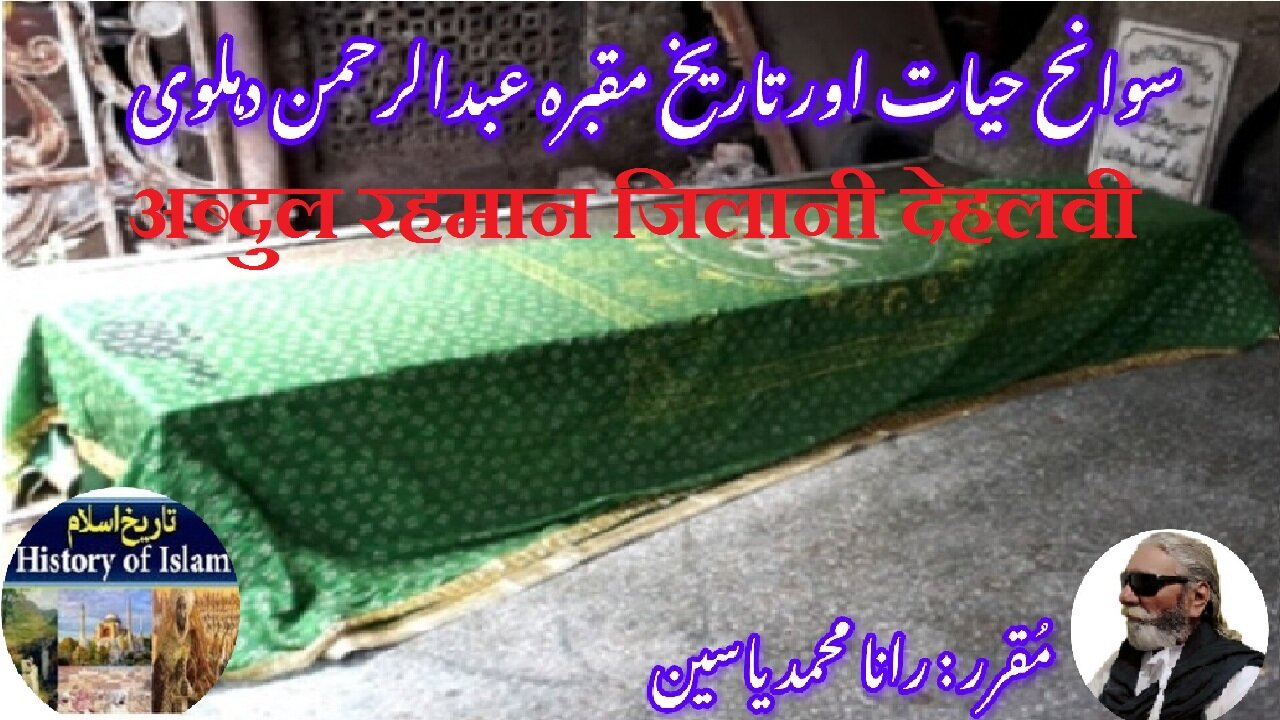Premium Only Content

Abdul Rehman Jilani Dehlvi जिलानी देहलवी عبدالرحمن جیلانی دہلوی کی سوانح عمری اور مزار کی تاریخ
@islamichistory813 #sufisaint #culturalheritage #biography #abdulrehmanjilani #dehlvi #islamicmysticism #islamicphilosophy #shrine #historicalfigures
Biography of Abdul Rehman Jilani Dehlvi and the history of his shrine
Dekhti Aankhooon aur sountay kaanoon ko Asslamoalaikum, sisters, brothers friends and elders, in informative series videos of Islamic ascolars, sufisaints, cultural heritages, islamic philosophys, islamic mysticisms and historical figures. today we are describing biography of Abdul Rehman Jilani Dehlvi and the history of his shrine.
Abdul Rehman Jilani Dehlvi was a Sufi saint of the Qadri Order in the Indian Subcontinent. His predecessors include Abdul Qadir Jilani, who initiated the lineage (silsila) of the Qadri order. He helped to establish the order in Delhi.
Abdul Rehman Jilani was born in 1615 (1024 AH) in Hama, Syria.[citation needed] He was the son of Abdul Qadir, a dervish from whom he received his early education.[citation needed] At 35, he chose to stay at the tomb of Abdul Qadir Jilani in Baghdad for three years. On 15 October 1652 (13 Dhu al-Qi'dah 1062 AH), during the Mughal era of emperor Shah Jahan, he went to India to meet Abdul Jaleel. He pledged allegiance on 10 Dhu al-Hijjah 1062 AH (10 November 1652 AD) and went to Delhi on 8 January 1653 (9 Safar 1063 AH). Here he resided himself and made a Khanqah. This is where his shrine is built as well as a mosque called Shah Abdul Rehman Mosque. Present Sadar station and quarters of Muslim Waqf board are built on his land.
At the age of thirty five, he came to Baghdad from Hama. There he stayed in seclusion for three years at the shrine of his great ancestor Shaikh Abdul Qadir Jilani. Then Shaikh Abdul Qadir Jilani esoterically ordered him to go to India and meet Shaikh Sayyid Abdul Jaleel. At that time, he was thirty eight years of age. On Tuesday, 13th Dhul al-Qadah, 1062 H (15th October 1652 AD), he reached India via Iran and Afghanistan in the reign of Shah Jahan.
He met Sayyid Abdul Jaleel who lived near the river Indus or Burhanpur or Adilpur. Further he took oath of allegiance upon his hands on Monday, 10th Dhul al-Hijjah, 1062 H (10th November, 1652 AD). Then at his orders, he went to Delhi on Wednesday, 9th Safar, 1063 H (8th January, 1653 AD). Here, he bought some land and built his house and a khanqah where his shrine is situated now. He also built rooms for residence of disciples on the land around the khanqah as well as a mosque. The name of the mosque is Shah Abdul Rehman Mosque. Present Sadar station in old Delhi and quarters of Muslim Waqf Board are built on his property.
Sayyid Abdul Rehman Jilani spent his life in anonymity. As he never appreciated fame and never went to the royal court or met the rulers and officials. Moreover he was the Fakir of Qadri order and had Divine powers. Given that he blessed a large number of people in Delhi and its vicinity with his beneficence. Hence, lacs of people became his disciples. He was a Qaim Maqam Fakir i.e. the Fakir who benefits people while staying at one place. Therefore there is not any evidence that he ever went out of Delhi once he settled there.
Why did Sayyid Abdul Rehamn Jilani come to India
It is believed that Shaikh Abdul Rehman went to India to fulfil the Divine command of transferring Divine Trust to Sultan Bahoo. He knew that Sultan Bahoo would be the one who would spread Faqr (Sufism) unlike any other Shaikh and his teachings would continue till eternity.
Second to spiritually support and help Aurangzeb to ascend the throne. So to enliven the Mohammadan sharia. In essence it was the spiritual power of Sayyid Abdul Rehman Jilani which he exercised behind the victories of Aurangzeb. All in all it exterminated heretical practices prevailing in that era. Abdul Rehman Jilani transferred the responsibility to Sultan Bahoo and passed away. Further Sultan Bahoo’s spiritual assistance made it possible for Aurangzeb to establish the greatest Mughal Empire and vivify the Mohammadan sharia.
At the age of 41, Abdul Rehman Jilani Dehlvi married Zahida who belonged to Jilani Sadaats and had 2 sons: Taj-ul-Arifeen and Abdul Aziz. In 1075, Taj-ul-Arifeen died of complications from diarrhea. Abdul Rehman Jilani Dehlvi lived a life of anonymity not giving attention to fame or the royal court of the Delhi Sultanate.
He stayed within Delhi and guided people spiritually, never leaving the city. Hence, he is also termed as Qaim Maqam Faqeer[further explanation needed]. His descendants preserved his teachings, notably his great grandson Abdullah Shah Madni Jilani in Ahmadpur Sharqiah, Bahawalpur district, Pakistan.
Abdul Rehman Jilani's senior successor was Sultan Bahoo. His junior successors included Shah Habib Allah Qadri and Mohammad Siddique, who was the first caretaker of his shrine.[3] Sultan Bahoo was Abdul Rehman Jilani's disciple, a saint of the Qadri family.
Abdul Rehman Jilani Dehlvi is one of the most recognized Sufis of the Qadri order after its founder Abdul Qadir Jilani.
Syed Shaikh Abdul Rehman Jillani was one of the most eminent saints of Dehli. His genealogy traces back to Shaikh Abdul Qadir Jilani. He was distinguished in piety and mysticism and held a high position in revelations and miracles. Syed Abdul Rehman Jillani received spiritual beneficence of the Qadiriyya way from his Murshid Syed Abdul Jaleel. The Qadiriyya way flourished in and around Dehli due to him. Countless Seekers of Allah became his disciples and he blessed many of them with Khilafat and Ijazat (permission to guide others). The famous saint Sakhi Sultan Bahoo was also his disciple.
The Qadri order branched with Sultan Bahoo to form the Sarwari Qadri order. Its disciples started adding Sarwari Qadri to their name. Many Sufi students and descendants became prominent from this order.
Sayyid Abdul Rehman Jilani was the disciple of Sayyid Abdul Jaleel who was the disciple of Sayyid Abdul Baqqa disciple of Sayyid Abdul Sattar disciple of Sayyid Abdul Fattah disciple of Sayyid Najamuddin of Burhanpur disciple of Sayyid Mohammad Sadiq Yahya Jilani disciple of Sayyid Abdul Jabbar bin Abu Saleh Nasr disciple of Shaikh Sayyid Abdul Razzaq Jilani disciple of Shaikh Abdul Qadir Jilani.
Who were spiritual successors of Sayyid Abdul Rehman Jilani
Sultan Bahoo was the superior spiritual successor (al-khalifah al-akbar ) of Sayyid Abdul Rehman Jilani. The junior successors (al-khalifah al-asghar ) included Shah Habibullah Qadri and Sayyid Mohammad Siddiq who was also the first caretaker of his shrine.
Sayyid Abdul Rehman Jilani Dehlvi died in the reign of emperor Aurangzeb on Friday night, the 21st of Ramadan 1088 H (16th November 1677 AD).
When urs of Sayyid Abdul Rehman Jilani is celebrated
Disciples would celebrate Sayyid Abdul Rehman Jilani’s death anniversary on 21st Ramadan with great zeal and zest for a long period. Till now, devotees celebrate it on 21stRamadan.
Sayyid Abdul Rehman Jilani’s grave is in his apartment. His junior spiritual successor Sayyid Mohammad Siddiq was the first caretaker of his shrine. Sayyid Mohammad Siddiq died childless in the reign of Aurangzeb. Neither his date of death is in any book nor information of his grave. During the British rule, a road, a railway track and the Sadar railway station were under construction. Now the railway track was slightly sidetracked. As to keep the shrine of Sayyid Abdul Rehman shrine safe. A compound was made around the shrine to keep it separate from the railway system.
The Hindus who migrated to India from Pakistan in 1947 after the division of the sub-continent occupied the vast land adjacent to the shrine of Sayyid Abdul Rehman Jilani by conspiring with the members of Muslim Waqf Board, just as they had done with the other shrines and Muslim khanqahs. Now his shrine is just a small room and Shah Abdul Rehman Mosque is present nearby. All the surrounding land which was actually the property of Sayyid Abdul Rehman and was a part of his shrine is now in the custody of illegal occupants. Let us discuss with reference to Indian books that how these people encroached the shrines and other properties left by Muslims.
Abdul Rehman Jilani's death anniversary is celebrated on 21 Ramadan.
With this, we seek your permission until tomorrow, tomorrow we will describe the biography of Abdul Karim Jili and the history of his Shrine. Allah Hafiz.
==================
-
 23:21
23:21
Simply Bitcoin
1 day ago $19.19 earned$1M Bitcoin in 2025? | Trump's Plan to End the Fed Revealed!
96.6K44 -
 17:19
17:19
SLS - Street League Skateboarding
17 days agoTop Moments from the Men’s Super Crown Final! Nyjah Huston, Giovanni Vianna and Gustavo Ribeiro 👑
52.5K -
 LIVE
LIVE
Major League Fishing
3 days agoLIVE! - Bass Pro Tour: Stage 1 - Day 3
768 watching -
 47:00
47:00
vinndoggradiousa
5 days agoBYE LEGACY MEDIA guest/ Sam Anthony of YourNews.com
5.7K -
 13:55
13:55
Clownfish TV
15 hours agoOrcs REMOVED from Dungeons & Dragons New Monster Manual?!
6.12K4 -
 15:38
15:38
Chris From The 740
6 hours ago $1.82 earnedThe EAA Girsan Match X 2311 : Premium Features, Unbeatable Value!
25.4K8 -
 14:23
14:23
Degenerate Jay
3 hours ago $0.25 earnedPeople Forgot What Metal Gear Solid Is?
13.6K3 -
 1:01:23
1:01:23
FamilyFriendlyGaming
16 hours ago $3.34 earnedCat Quest III Episode 14
30.4K -
 3:16:59
3:16:59
RG_GerkClan
5 hours ago🔴LIVE - Dominating One Raid at a Time - Escape From Tarkov - Gerk Clan
27.8K1 -
 1:49:43
1:49:43
Game On!
14 hours ago $2.12 earnedNFL Experts Top 10 Super Bowl Props!
23.3K2